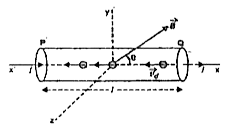The direction of force experienced by a current carrying conductor placed in a magnetic field is given bySolution in Punjabi
Consider a conductor PQ of length l having area of cross-section A and lying along X-axis.
Let →B= Magnetic field which acts in XY plane making an angle θ with the X-axis.
I= current flowing through conductor from P and Q.
Electron in the conductor move in a direction opposite to that of direction of current i.e., from Q to P.
→vd= Drift velocity of electrons.
→Fm= Magnetic Lorentz force experienced by an electron.
→Fm=−e(→vd×→B)
If n = Number of electrons per unit volume of the conductor.
Total number of electrons in the conductor = N
N=n× Volume of conductor N∝n×Al=nAl
∴ Total force on the conductor itself is equal to the force acting on all the free electrons moving in the conductor in the magnetic field and is given by

→F=N→Fm=nAl[−e(→vd×→B)]
=−nAle(→vd×→B)
We know I=≠AvdorIl=≠Alvd
I→l represents a current element vector and it actsin the direction of flow of current, i.e., along +ve X-axis. As I→l and drift velocity →vdare acting in opposite directions, so we can write
I→l=−nA≤→vd
from eqn. (1), we have
→F=I(→l×→B)
Direction of force :
The direction of →F can be found using the rule for the direction of cross product (→l×→B) which can be found by right hand screw rule or Fleming.s left hand rule. Thus, it acts perpendicular to the plane containing →l and →B and directed upward, i.e., along + Z-axis.
The magnitude of force →F is given by
F=IlBsinθ ...(2)
Where θ is the smaller angle between I→land→B.
Special cases : (i) If θ=0∘or180∘,sinθ=0, then from eqn. (2), Force , F = 0 (minimum).
It means that a current carrying conductor does not experience any force when placed parallel or antiparallel to the direction of magnetic field.
(ii) If θ=90∘,sinθ=1, then from eqn. (2)
F=I/B (maximum)
It means that a current carrying conductor placed at right angle to the uniform magnetic field experiences a maximum force. The direction of force in this case can also be determined by Fleming.s left hand rule or right hand screw rule.
Topper's Solved these Questions
- FORCE ON A CURRENTBOOK - BETTER CHOICE PUBLICATIONCHAPTER - FORCE ON A CURRENTEXERCISE - SHORT ANSWER TYPE QUESTIONS (MOST EXPECTED QUESTIONS)
5 Videos
- FORCE ON A CURRENTBOOK - BETTER CHOICE PUBLICATIONCHAPTER - FORCE ON A CURRENTEXERCISE - LONG ANSWER TYPE QUESTIONS
15 Videos
- FORCE ON A CURRENTBOOK - BETTER CHOICE PUBLICATIONCHAPTER - FORCE ON A CURRENTEXERCISE - VERY SHORT ANSWER TYPE QUESTIONS (MOST EXPECTED QUESTIONS )
5 Videos
- FORCE ON A CHARGE BOOK - BETTER CHOICE PUBLICATIONCHAPTER - FORCE ON A CHARGE EXERCISE - NUMERICAL PROBLEMS
14 Videos
- GAUSS'S THEOREMBOOK - BETTER CHOICE PUBLICATIONCHAPTER - GAUSS'S THEOREMEXERCISE - MOST EXPECTED NUMERICALS
4 Videos
Similar Questions
What is a safety fuse? Explain its function.
View SolutionState the principle of moving coil galvanometer?
View SolutionDefine an ampere in terms of the force between current carrying conductors.
View SolutionAn electron (with charge 1.6×10−19C) moving at right angles to a uniform magnetic field completes a circular orbit in 10−6sec. Calculate the vlaue of magnetic field. Given mass of electron =9×10−31kg.
View SolutionA box encloses an electric dipole of 3μCand−3C, if the dipole length is 6 cm, then find total electric flux associated with box.
View SolutionWhen is the force experienced by a current-carrying conductor placed in a magnetic field is largest?
View SolutionMention the between a current carrying conductor and magnetic field for which the force experienced by this current conductor placed field is largest ?
View SolutionThe direction of force experienced by the current carrying conductor in a uniform magnetic field a given by
View SolutionThe direction of force on a current carrying conductor placed in a magnetic field is given by _________ .
View SolutionWhen is the force experienced by a current carrying conductor placed in a magnetic field largest ?
View SolutionWhen is the force experienced by current carrying conductor placed in a magnetic field largest ?
View SolutionWhen is the force experienced by current carrying conductor placed in a magnetic field largest ?
View SolutionWhen is the force experienced by current carrying conductor placed in a magnetic field largest ?
View SolutionWhen is the force experienced by a current-carrying conductor placed in a magnetic field largest?
View SolutionWhen is the force experienced by a current-carrying conductor placed in a magnetic field largest ?
View SolutionWhen is the force experienced by a current-carrying conductor placed in a magnetic field is largest?
View Solution
